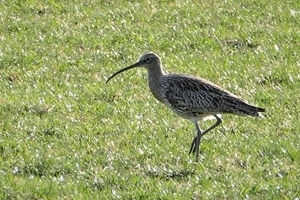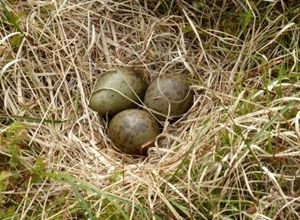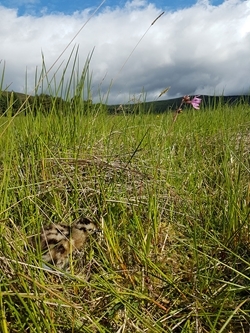Contents
A species in decline
The curlew we have in the UK is one of eight species found worldwide, two of which are already likely to be extinct. There have been no confirmed sightings of eskimo curlew for over 50 years or slender-billed curlew for 15 years. Our species, the Eurasian curlew, is also facing this threat, and we must do all we can to prevent its continued decline, and possible loss, from the UK.
 The curlew used to be a common species in Britain, breeding in marshes, meadows and arable fields as well as on moorland. However, the curlew population has declined rapidly in recent decades. There are now only half the number of breeding curlew in the UK compared to 25 years ago. The curlew was added to the UK red list in in December 2015, and it is argued to be the most pressing bird conservation priority in the UK. The famously evocative and previously familiar call of the curlew is becoming increasingly rare.
The curlew used to be a common species in Britain, breeding in marshes, meadows and arable fields as well as on moorland. However, the curlew population has declined rapidly in recent decades. There are now only half the number of breeding curlew in the UK compared to 25 years ago. The curlew was added to the UK red list in in December 2015, and it is argued to be the most pressing bird conservation priority in the UK. The famously evocative and previously familiar call of the curlew is becoming increasingly rare.
The UK plays an important role in shaping the future for curlew because we hold important breeding and overwintering populations – our coastal areas are estimated to support a fifth of the world’s curlew in winter, with around a quarter of the world’s pairs breeding at UK sites in spring and summer. With so many of the world’s curlew within our borders, the UK has an obligation to do all we can to protect them. What happens to curlew in the UK will have serious consequences for the global population.
Low breeding success
 Lots of research has been done looking at the reasons for curlew population declines, and found that overall the problem is low breeding success, not poor adult survival. This knowledge is important because we now know research and conservation efforts should be focused on the breeding grounds.
Lots of research has been done looking at the reasons for curlew population declines, and found that overall the problem is low breeding success, not poor adult survival. This knowledge is important because we now know research and conservation efforts should be focused on the breeding grounds.
A large review of scientific studies across Europe found that breeding success was so low that over 70% of nests between 1996-2006 were not able to hatch a single chick. Of those chicks that hatched, only half survived from hatching to fledging (the age where they are able to fly).
For the curlew population to remain stable, each breeding pair would need to produce, on average, 0.48-0.62 fledged chicks per year. Less than a chick per year per pair may seem like a fairly low figure, but the estimated breeding success actually seen across Europe is 0.348 chicks per year – too low to maintain the population, and leading to declines. There are many reasons for this, which include: loss, degradation and fragmentation of breeding habitat; high levels of nest and chick predation; agricultural nest destruction; and afforestation.
It is important to think about these factors with respect to the UK, to identify ways to best support breeding curlew and help promote recovery. Achieving the double goal of curlew conservation alongside economically successful farming is possible with the application of scientific knowledge, and is the most sustainable approach to recovering our curlew.
Pressures on breeding
Loss of breeding habitat
Ideal curlew breeding sites have wet areas for feeding and dry areas for nesting, with a mixed but medium length vegetation structure and little disturbance (see figure 1). For example: lowland wet grassland, in-bye land or unenclosed rough grazing on the moorland edge. Traditional management of these meadows and pastures consisted of grazing by sheep or cattle, with livestock exclusion during the spring and summer for cutting, perhaps with limited application of lime or manure. This can produce the ideal habitat for curlew.
Areas with these characteristics are becoming scarcer in the UK as pastures are improved with drainage, application of fertilisers and grass reseeding. The drier, more even grassland produced by this has fewer species of plants, leading to lower numbers and diversity of food species for curlew, such as insects and earthworms. Breeding curlew have declined sharply in lowland wet grasslands in the UK.
Furthermore, in part due to increased sheep grazing between the 1960s and 1990s, many breeding curlew have been lost from the moorland fringe. The increased management of this transition zone between moorland and farmland has contributed to substantial losses in both the number of breeding curlew and their breeding success in these areas in recent decades.
Despite historically having bred throughout the UK, habitat loss in the lowlands and inbye land means that curlew are now more often thought of as a bird of the uplands (see map). It is thought that there are now only 250-300 pairs of curlew breeding in the UK south of Birmingham. However, populations are also declining in upland areas and efforts are required across the country to preserve our curlew.
High levels of nest and chick predation
 As well as habitat pressures, it is well documented that predation is a serious threat to curlew breeding success.
As well as habitat pressures, it is well documented that predation is a serious threat to curlew breeding success.
As curlew nest on the ground, their eggs and chicks can be very vulnerable. Population declines driven by habitat loss have led to smaller local populations, which are less able to withstand negative pressures, and this vulnerability has become an increasing problem. As the same time, predation pressure may have risen in recent decades as fox and crow populations have shown long term increases.
One study showed that predation has increased from 16% to 65% of curlew nests predated per year across Europe, when looking at the periods pre-1980 compared to 1996-2006. In Northern Ireland, a study on nesting success found that up to 97% of nest failures and 74% of chick mortality were due to predation, mainly from foxes and predatory birds.
To examine the impact of this predation pressure, a GWCT study looked at the effect of performing predator control on moorland for breeding waders, including curlew. When predators were controlled, curlew bred three times more successfully than on the same moorland when predator control was withdrawn. Effective predator control is likely to be one reason why curlew breed better on moorland managed for red grouse. Comparative studies have consistently shown a higher density of curlew breeding on grouse moors than non-grouse moors. Given the population declines seen elsewhere, it may be that the management undertaken on grouse moors makes them a refuge for breeding curlew.
Agricultural nest destruction
Curlew breeding in farmland can be susceptible to accidental nest destruction by agricultural machinery or livestock. Lowland breeding sites are increasingly rare in some heavily farmed areas of the UK, however curlew frequently utilise such breeding sites in other countries and agricultural activities can destroy nests. In Scotland, many curlew do still nest in lowland sites and adjustments to farming practices during the breeding season may help accommodate their needs and promote thriving local populations.
As curlew bred historically in the lowlands in the UK, and continue to do so in many European countries, it may be possible to encourage a recovery here for the lowland curlew population. It is interesting to note that of the few areas where populations are increasing, albeit still small, some are in the lowlands. Conservation steps taken by farmers and land managers in lowland wet grassland, farmland and meadows may have the potential to preserve and support breeding curlew here.
Breeding curlew facts
Nests
- Nests are usually formed on flat ground, drier than the nearby foraging areas and ideally away from trees and shrubs that may conceal predators.
- Nests are a shallow cup in the grass sward, formed by the bird pressing down and turning around on the vegetation.
- The surrounding grass will usually be 20-30 cm high, so the sitting bird is concealed, but can raise its head to see the surrounding area.
Breeding behaviour
- Curlew are pair faithful and return to the same site year after year.
- When nesting, curlew are territorial and very secretive.
- They land some distance from the nest and approach it through long grass to conceal its location.
- Both male and female birds incubate the eggs, in shifts of two to three hours.
Incubation
- Eggs are usually laid by the first week of May.
- Up to four eggs per clutch are typically seen.
- Incubation takes about four weeks, and is shared by both adults.
- If eggs are lost, the pair may make a second attempt at nesting in the same year.
- If chicks are lost, the pair will not replace the clutch.
Fledging
- Once hatched, chicks are mobile and move away from the nest with the adult bird to feed within hours.
- Chicks eat a range of invertebrates and need a mixed vegetation structure to provide food, shelter and cover from predators.
- Chicks usually fledge (learn to fly) between 32-38 days from hatching.
- Early clutches typically fledge in mid-July, replacement clutches may not fledge until August.
What can I do?
Get involved
If you have curlew, let us know! Do they nest near you? Where are they? Are they breeding successfully? If not, do you know what is limiting their success? Did curlew nest, but not any more? What has changed. Submit your information and find practical advice at www.actionforcurlew.com.
How do I know if curlew are nesting?
Curlew typically nest between April and July. If you see pairs of curlew in March/April, they may be preparing to nest, and in May and throughout June, it is likely that they are nesting nearby. Nests are usually very discreet and difficult to find, and nesting birds are sensitive to disturbance so we do not advise searching for exact nest sites. Birds take turns to incubate their eggs, in shifts of about three hours.
Habitat
Maintenance of suitable breeding habitat is a critical starting point. This can include: maintaining wet pastures in the lowlands, keeping pastures unimproved, performing heather management to give patches of suitable length on moorland. Curlew return to the same area to nest in year on year, so these measures can be beneficial for many years.
Agricultural disturbance
Agricultural operations during the breeding season can be destructive for nests, or cause desertion if the adult birds are distressed. If you have nesting curlew, avoid cutting, rolling or excessive stocking between mid April and mid July. When you do mow, cut from the inside out, to allow chicks the chance to escape the machinery through unmown grass.
Control predators
Predator control can take the form of lethal control, or other options such as exclusion fencing. Predator control on moorland can benefit curlew and other waders nesting on the moor, as well as on the nearby rough grazing and farmland. If you run a shoot and perform predator control in summer, consider extending this to include the curlew breeding season.
GWCT Advisory Service
If you need advice on how best to manage your land for curlew, please contact our advisory team on 01425 651013 or advisory@gwct.org.uk. We are happy to discuss the available management options over the telephone and also offer free guidance via email. In many situations, it may be necessary to visit you in order to give site-specific advice.
For more information on our advisory service, please visit www.gwct.org.uk/advisory